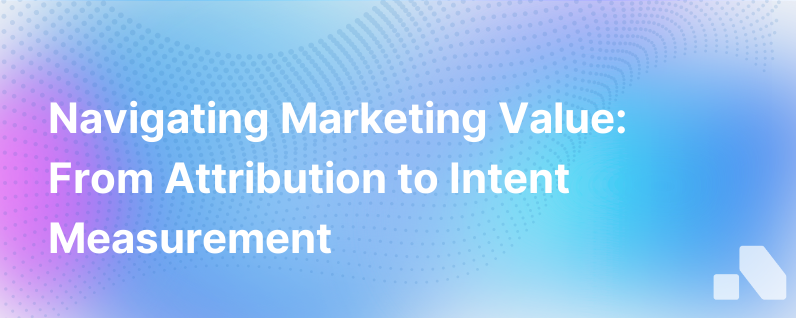
The landscape of digital marketing is in constant flux, with the disciplines of attribution and intent becoming focal points amidst the noise. As business-to-business (B2B) selling environments grow more intricate, marketers grapple with the challenge of quantifying their impact on the final sale. The once lauded practice of attribution is seeing a decline, while the significance of measuring intent is on the rise. Let’s explore why this is happening and what it means for marketing’s role in complex sales cycles.
Understanding Attribution in Marketing
Attribution in digital marketing involves assigning credit to particular touchpoints or channels that contribute to a sale or conversion. The model aimed to clarify the role that different marketing efforts played in the customer’s journey. From first-click to multi-touch attribution, the goal was to quantify each interaction's significance.
However, the reality has proven more complex than the attribution models can account for. In B2B sales, where the cycle can take months and involves numerous stakeholders, mapping a straightforward path to purchase becomes almost impossible. The high-touch, consultative nature of these sales defies the simplicity attribution models suggest.
Moreover, the increase in digital privacy concerns has led to limitations on cookie tracking. New regulations and browser policies restrict the flow of user data, complicating the already challenging task of following the digital breadcrumbs that lead to a purchase.
The Decline of Attribution
Attribution was once seen as the marketing Mecca, but cracks have emerged in the facade. With the complexity of the B2B buying process, involving an average of 6.8 stakeholders according to CEB (now Gartner), the idea of a linear journey is outdated. Buyers hop in and out of the sales cycle, consume content at their own pace, and carry out research independently. Moreover, these stakeholders often sit in different business functions, have varying levels of influence, and can change roles mid-cycle.
The cracks only widen with the emergence of integrated marketing strategies, where online and offline efforts blend seamlessly. Consider the overlap of trade shows, webinars, digital content, word-of-mouth, and direct sales outreach; it becomes apparent that assigning value to any single touchpoint risks oversimplification and misinterpretation.
Measuring Intent: The New Frontier
In the wake of attribution's pitfalls, intent data ascends as a vital business metric. Intent data encompasses user behavior indications that signal potential interest in your products or services. It reflects not just an action, but the motivation behind the action – a level of insight attribution models could never provide.
Instead of fretting over the exact contribution percentage of a white paper download, marketers are now looking at aggregate behaviors that hint at purchase readiness. Website visits, content downloads, webinar attendance, product comparison, and search activity come under scrutiny to discern a narrative of genuine buyer interest.
Technologies are emerging to harvest this rich seam of intent data. Platforms that can analyze real-time search data, apply AI to predict buyer behavior, and track content interaction offer a more nuanced view of the customer journey. This focus on intent offers a clearer picture of where a prospect is in the buying process and how marketing can effectively engage them.
Marketing's Value in a Complex Sale
Complex sales emphasize the value of relationships, understanding, and trust. Marketing, with its newfound focus on intent, is uniquely positioned to influence these areas. By providing valuable, tailored content at crucial moments, marketing nurtures the prospect's journey and subtly shapes their perception of the brand. It’s no longer about staking a claim on the final conversion but instead demonstrating an ongoing contribution to the layered fabric of decision-making.
Marketing's role is now more strategic than ever. It involves a delicate balancing act of identifying accounts showing signals of purchase intent, educating and nurturing them with relevant content, and coordinating with the sales team to ensure a unified approach to engagement. This alignment is critical; when sales and marketing share intent data, the two can synchronize their strategies, leading to a more cohesive and effective pursuit of key accounts.
The accessibility of granular intent data allows marketers to become more agile, pivoting tactics based on real-time shifts in market dynamics or customer behavior. This agility is essential in the B2B sphere, where the status quo can change abruptly due to factors like mergers, emerging regulations, technological innovations, or global economic shifts.
Embracing a Culture of Data-Driven Empathy
The ascent of intent data also heralds a broader shift in marketing philosophy: a move towards data-driven empathy. By analyzing patterns and behaviors, marketers amplify the voice of the customer, feeding these insights back into product development, sales strategy, and customer success. This virtuous cycle of learning and applying ensures that companies can compete on the axis of customer experience, which is becoming the ultimate battleground for differentiation.
A Parting Thought
In conclusion, as we witness the decline of simplistic attribution models, the need for sophisticated intent measuring becomes starkly clear. The rise of intent data empowers marketers to add value not by dominating the conversation about ROI, but by illuminating paths through the labyrinth of modern B2B sales — paths laden with empathy, insight, and strategic acumen.
With platforms like Aomni, B2B sales teams are equipped with the latest tools to interpret buyer signals intelligently and navigate the complex sales landscape. By harnessing the intent data and applying it meticulously within the sales cycle, marketers can better forecast trends, prioritize outreach, and ultimately, drive strategic growth.